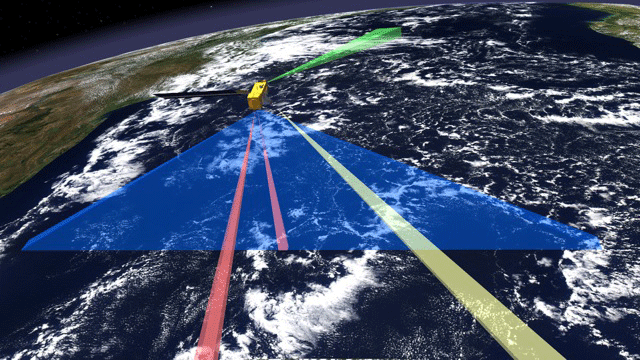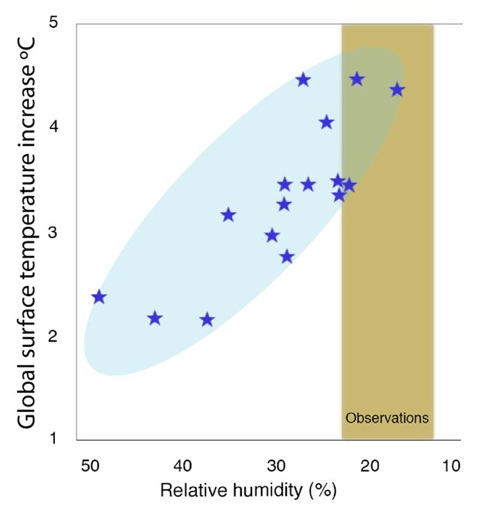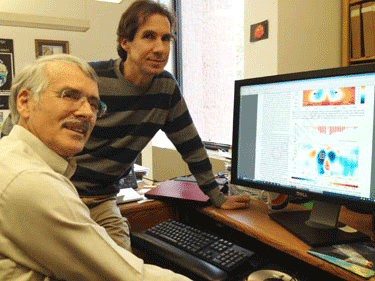The Best Climate Projections Are Extreme
Air Date: Week of November 16, 2012

A NASA satellite used to gather information about cloud-related data linked to climate change (photo: John Fasullo)
Scientists agree that the planet is warming, but there is a wide range of projections as to how hot it’s going to get. A new analysis from scientists at the National Center for Atmospheric Research finds that the more alarming estimates may be the most accurate. John Fasullo, one of the climate scientists responsible for the analysis, joins host Steve Curwood to discuss the future of our warming planet.
Transcript
CURWOOD: From the Jennifer and Ted Stanley Studios in Boston, this is Living on Earth. I'm Steve Curwood. The scientific consensus holds that climate change is upon us, but there are many different projections as to how fast it's happening - and how hot it might get. Now a new study has found that the most alarming global warming estimates may in fact be the most accurate.
Joining us is one of the report’s lead authors, John Fasullo, a climate scientist at the National Center for Atmospheric Research in Boulder, Colorado. Welcome to Living on Earth!
FASULLO: Thanks for having me.
CURWOOD: So, what are the various projections that have been made about the extent of global warming?
FASULLO: Well, we have a range of about three degrees Fahrenheit to about eight degrees. To make it more understandable, the basic question we’re trying to answer is whether or not New York City becomes more like Richmond, Virginia, in the future, or whether it becomes more like Atlanta, Georgia.
CURWOOD: Now, when you say three to eight degrees are you talking Fahrenheit or are you talking Celsius?

Graph detailing the results of Fasullo’s analysis (photo: John Fasullo)
FASULLO: We’re talking Fahrenheit and we’re talking by 2100. So, of course, there is the capacity for further warming after that, or if we take action to curb climate change, less warming eventually.
CURWOOD: So, why is there such a large range between these estimates?
FASULLO: Well, it all depends on how clouds change in the models. The largest source of uncertainty is how clouds will change in a warming environment. Some models suggest that clouds will increase and reflect more sunlight back to space while other models show clouds will actually decrease in extent and will actually let more sunlight into the system.
CURWOOD: So how did you take cloud cover into account for your analysis?
FASULLO: The evaluation of clouds in models is difficult, they’re a challenge because our observation of clouds are not too good, and then comparing those observations to models isn’t straightforward – it’s not an apples to apples comparison. So, we tried to skirt this whole issue by looking at the environment in which clouds occur, rather than clouds themselves. Things like relative humidity in the environment. And, over the past ten years, we’ve had NASA satellites that have observed relative humidity on a global scale throughout the atmosphere. And so, we’ve been able to take those observations and ask the question which models actually produce the relative humidity variations more accurately.
CURWOOD: Which of the projections ended up being the most accurate?
FASULLO: Well it turns out that there’s a set of models that is generally on the low end of the spectrum for projecting the future that does a very poor job in resolving these basic interactions that we see in the observations. There are these areas of the tropics called the dry zones, and we think of the tropics as being very moist, but in fact, once you get away from the surface of the tropics, most of the tropics is actually very dry.
These dry zones expand over time; you can think of this as the iris of the climate system. That iris opens up and the amount of clouds decreases, therefore letting more sunlight into the system and adding to additional warming. There is a set of models that’s generally doing this very well, and those tend to be on the higher end of the spectrum for projections.
CURWOOD: Which models are those?
FASULLO: One is from the UK MET office. One is from NCAR where I work in Boulder, Colorado, and one is from Japan.
CURWOOD: Now, the Intergovernmental Panel on Climate Change – that is made up of literally thousands of scientists from around the world – the models that they have accepted have consistently underestimated the extent of warming. Now why do you suppose that is?
FASULLO: Well, I think that body tends to be fairly apolitical, and is hesitant to make a judgment on which models are more reliable unless there is some very sound scientific basis for doing so. So they tend to weight all of the models in the scientific community evenly, even though we know that some of the models are better than others. So this is an attempt to provide an objective measure as to which models are doing the best. And therefore, maybe we should screen out a few of the models before we make a projection of what the future holds.
CURWOOD: What are the prospects of the Intergovernmental Panel on Climate Change, taking your research and applying it to their next series of reports, which come next year?
FASULLO: Well, they have included my analysis in their next report. And so it will be up to the authors on how they incorporate that information. It’s a very difficult problem, it’s been around for 30 years, and they’re going to be hesitant to make any bold proclamations based on a single study. And I think they should be. I think that science generally works by consensus and an evolving understanding of the issues.
So this will be one piece of evidence that they consider, but really there needs to be a broader effort across the scientific community to improve models and create a more complete picture as to what the possible future may hold.
CURWOOD: Based on your study, how hot do you think the world is going to get?
FASULLO: We feel that the upper half of the range of five degrees Fahrenheit to eight degrees Fahrenheit is probably most likely by 2100. But a lot of that warming is really up to us as well – how much are we going to emit into the atmosphere and how strongly are we going to force the climate system. And that is something that we can control and we should really make a focus.

John Fasullo (right) and his Colleague at NCAR Kevin Trenberth (photo: John Fasullo)
CURWOOD: What would the world be like five degrees hotter?
FASULLO: Some of these scenarios that we look at in these models are really quite alarming. It’s a whole different world. The character of snow, of sea ice, of the Arctic changes considerably. And that doesn’t even touch on the question of adaptation – whether certain parts of our environment are going to be able to adapt to such a sudden and really large shift in temperature zones.
CURWOOD: What do you hope comes out of this research?
FASULLO: Well, we have two main messages. And one is, from a policy standpoint, we really need to consider the best science in forging the best policy concerning global warming. And it certainly is upon us and is going to continue to get worse. Putting our heads in the sand doesn’t help us prepare for the future that we’re getting into. The other message from our study is to model in communities. And to give a message as to how best to improve models so that we can better serve the needs of society.
CURWOOD: What’s it like to work on climate research in a nation where there’s been so much well-funded skepticism against this concept?
FASULLO: It’s a challenge. And I think most of the scientists who work in the field have a sense that eventually the truth will win out. But what’s frustrating is that we are, in some ways, racing against the clock. We keep emitting greenhouse gasses into the atmosphere and then wait to deal with it, we’re going to look at greater impacts overall with sea level rise and weather extremes. And so the more we delay action, the more expense we have to deal with instead of dealing with it inexpensively up front and as soon as possible.
CURWOOD: John Fasullo is a climate scientist at the National Center for Atmospheric Research in Boulder, Colorado. Thank you so much, John.
FASULLO: Thank you Steve.
Links
Fasullo and Trenberth study in Science Magazine
Met Office UK Climate Projections for 23 Countries including US
Met Office UK Climate Modeling Methodology
The Atmospheric and Ocean Research Institute (AORI) of the University of Tokyo
Living on Earth wants to hear from you!
Living on Earth
62 Calef Highway, Suite 212
Lee, NH 03861
Telephone: 617-287-4121
E-mail: comments@loe.org
Newsletter [Click here]
Donate to Living on Earth!
Living on Earth is an independent media program and relies entirely on contributions from listeners and institutions supporting public service. Please donate now to preserve an independent environmental voice.
NewsletterLiving on Earth offers a weekly delivery of the show's rundown to your mailbox. Sign up for our newsletter today!
 Sailors For The Sea: Be the change you want to sea.
Sailors For The Sea: Be the change you want to sea.
 The Grantham Foundation for the Protection of the Environment: Committed to protecting and improving the health of the global environment.
The Grantham Foundation for the Protection of the Environment: Committed to protecting and improving the health of the global environment.
 Contribute to Living on Earth and receive, as our gift to you, an archival print of one of Mark Seth Lender's extraordinary wildlife photographs. Follow the link to see Mark's current collection of photographs.
Contribute to Living on Earth and receive, as our gift to you, an archival print of one of Mark Seth Lender's extraordinary wildlife photographs. Follow the link to see Mark's current collection of photographs.
 Buy a signed copy of Mark Seth Lender's book Smeagull the Seagull & support Living on Earth
Buy a signed copy of Mark Seth Lender's book Smeagull the Seagull & support Living on Earth

